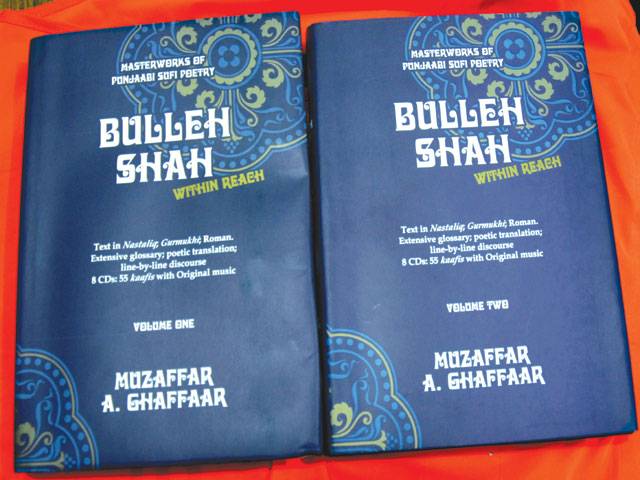Punjabi is the 10th most spoken language in the world. About 150 million people speak today. Its literature particularly poetry is among the richest in the world. Unfortunately the language is on the decline. Due to increasing demand for English as medium of instruction in both Pakistan and India students generally do not learn Punjabi language and literature. Then about 10 million Punjabis live outside South Asia in different countries and do not have access to Punjabi literature nor can read it.
The book under review ‘Bulleh Shah Within Reach’ published by Ferozsons (Pvt Ltd) in two volumes is an attempt to reach young people and general public who cannot read Punjabi or do not have access to Punjabi literature. It has text in Nastaliq, Gurmukhi and Roman with extensive glossary; poetic translation; line-by-line-discourse that have been supplemented with eight CDs having 55 kaafis with original music. The inclusion of CDs is attempted to recreate the oral tradition, which like the reading of poetry is also fading away.
Hats off to author, Muzaffar A Ghaffar, who has done painstakingly good job in writing this book that is error free and does not confuse a layman, who is reading Bulleh Shah for the first time. He is well known personality in the world of bookmen and has to his credit many books. His major publications have been published under the umbrella name Masterworks of Punjabi Sufi Poetry, in 29+ volumes. Books on Baaba Fareed Ganjshakar, Baba Naanak, Shah Husayn, Sultan Baahu, Sachal Sarmast and Khwajja Ghulam Fareed. The book under review is a reference book and is delightful reading for both the scholars and students.
In introduction to the book the writer mentions that it is possible that Bulleh Shah did not formally write down his poetry or encourage anyone else to do so under his direction. It is possible that parts of his verse have been lost in the tumult of the times from 1740 to 1750. The first compilation of Bulleh Shah’s work was published in 1882. Therefore, before that it may be assumed that qawaals and storytellers were the custodians of verse. It was common in rural areas to hear the kaafis and poetry of Bulleh Shah and other Punjabi poets. Reading this book I remember hearing the same kaafis from my father and perhaps he had heard them from his father. This tradition of passing on what you have learned passed from generation to generation. It was heartening to read the kaafis with their true meaning again after say nearly three decades.
The writer has made sure that nothing is lost in translation. He has taken great pains in ensuring that. The attempt is to stick to what was written originally. The writer’s approach is to use a studiously edited text, present it in Nastaliq, Gurmukhi, and Roman transliteration, provide an extensive glossary, produce a poetic translation, which follows the rhyme scheme of the poet and preserve the integrity of each line and offer notes on poetics, history, society, culture, intellectual issues, Sufism, etc., with each line.
The Roman devised for this series tries to overcome the problems that certain sounds in Punjabi are not present in Urdu or Hindi. English alphabet does not produce certain sounds. For example some words make us of the ‘o’ sound such as door (far), god (lap) and poor (fill). In Roman of this series, certain words have been adjusted because as written in Roman that word is extant in English. Examples: sir (head) is written as sir, sat (seven) as saat, etc. An apostrophe ‘s’ (‘s) is sometimes used at the end of a word as a replacement for ‘is’ or ‘has’ in the translations.
The writer has presented each piece of poetry as a separate chapter. The writer has tried his best to ensure in the notes that nothing may appear to present any particular point of view or ideology. Kaafis are considered songs to be sung and not poems to be read. Therefore the writer has presented CDs containing the Kaafis in original music. Kaafis are in recitation as well as original high quality music along with musical notations. The rhythmical movement of Bulleh Shah’s kaafis on the oral tradition is unmatchable and mesmerising. The poet definitely had very good knowledge of classical and folk music is essential element of his poetry. Many of his songs have been adapted or adopted to create greatest musical hits of South Asia.
Bulleh Shah’s kaafis have layers of meanings. He slams the religious scholars and intellectuals for their practices and what they in reality preach. He criticizes those who worship to show off in front of others rather than worship the Almighty in true essence. He was against religious clerics who he believed were doing business in the name of religion. His poetry reflects adoration and love for God and Prophet Muhammad (PBUH). His poetry would definitely appeal to today’s generation who too like him live in an age of transition where corruption and falsehood is in abundant. Bulleh Shah lived at the time when the Mughal Empire was collapsing and new political forces were trying to replace it. The people were most to suffer in those trying times. In today’s world extremism is on the rise and state fails to provide welfare to its citizens. The poetry of Bulleh Shah has not lost its relevance in today’s world. In fact people would find it more appealing.
Who am I, what do I know?
Bullah who am I, what do I know?
Neither in mosques an orthodox acolyte
Nor in any blaspheming rite
Nor pure amongst the defiled, recondite
Neither Moses, nor Phiroh
The verses recited for centuries carry layers of meaning in the Sufi way – The way of Bulleh Shah. They have been interpreted in many ways. The thought provoking poetry is soul stirring in its own strange way and a must read for those that have not.






